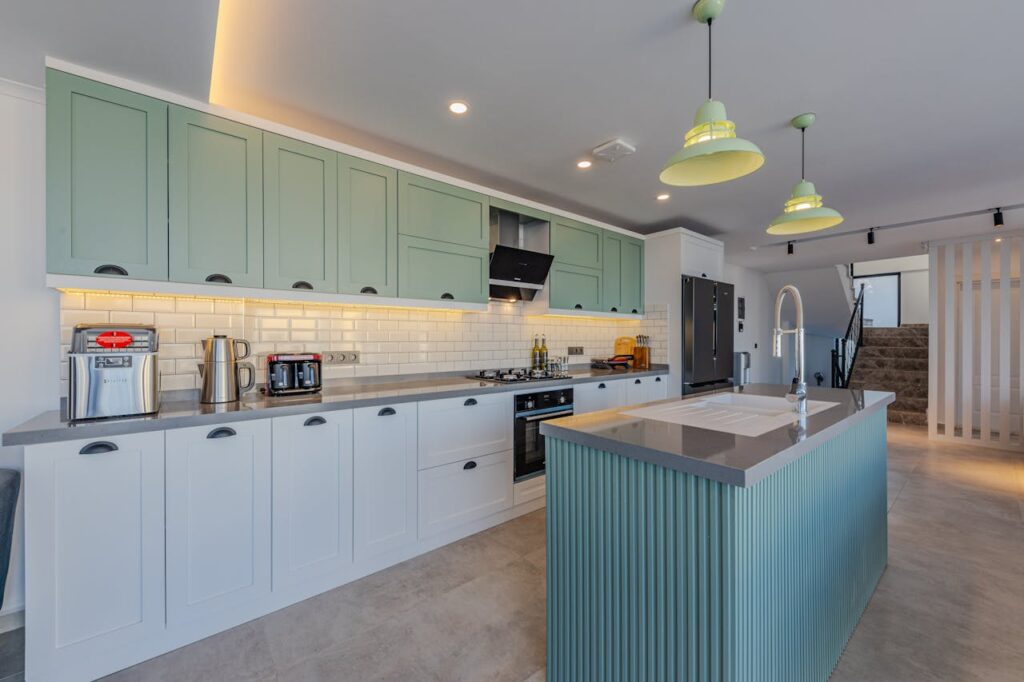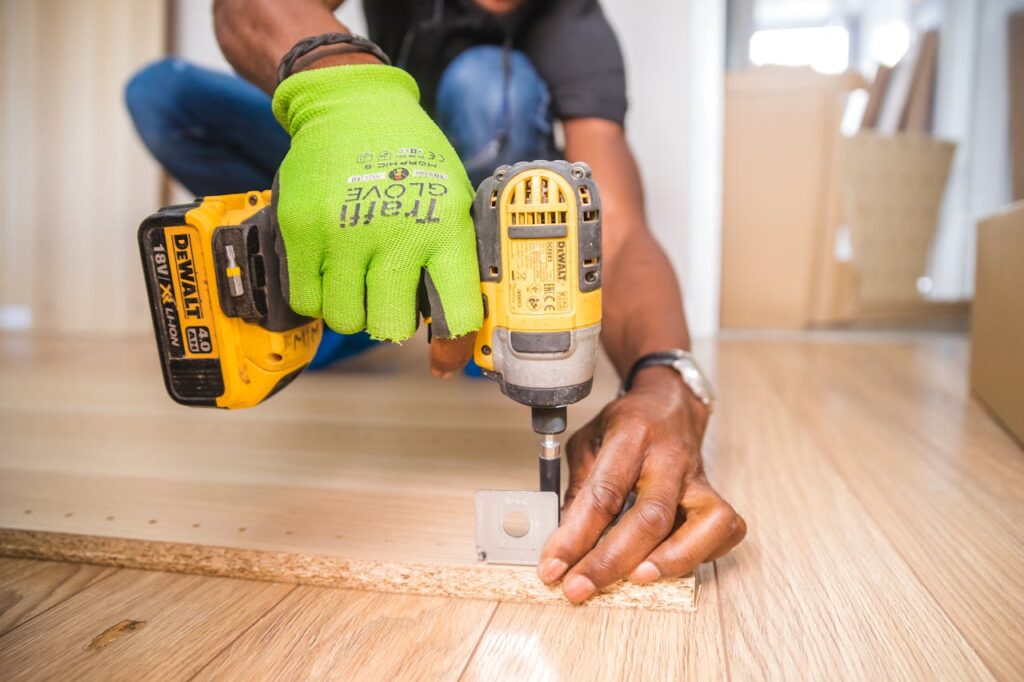Planning a kitchen remodel can feel like a big job. There are many things to think about, but one of the most important is your appliances.
Appliances like your fridge, stove, and dishwasher take up space and need special spots. If you don’t plan for them well, your kitchen might not work the way you want.
In this post, we’ll show you how to plan a kitchen remodel around appliance needs in mind. You’ll learn how to choose the right places for your appliances, think about size and style, and make sure everything fits perfectly.
By the end, you’ll feel ready to create a kitchen that looks great and works well every day.
Key Takeaways
- Know your appliances first — Measure them and understand what each one needs to work well.
- Plan appliance placement wisely — Keep things like the fridge, stove, and sink close enough for easy cooking.
- Think about size and style — Choose appliances that fit your kitchen space and match your design.
- Don’t forget power and ventilation — Appliances need proper outlets and air flow to be safe and work right.
- Plan for the future — Consider how your appliance needs might change over time, so your kitchen stays useful.
Why Appliances Should Drive the Design (Not the Other Way Around)
When you start planning your kitchen remodel, it might be tempting to think about colors, cabinets, or countertops first. But the appliances should come before all that.
Here’s why:
Appliances Need Space and Power
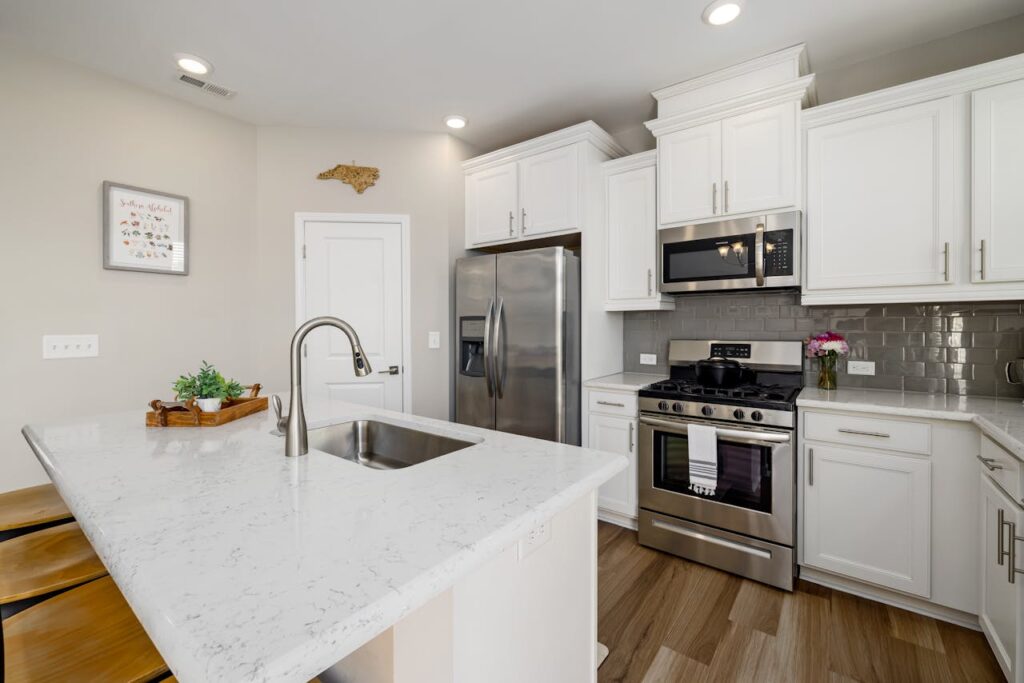
Appliances like your fridge, oven, and dishwasher need a certain amount of space to fit and work safely. For example, a big fridge needs enough room for the doors to open fully. If the design squeezes it too tight, you won’t be able to get your food out easily.
Also, appliances need power. Your stove might need a special kind of outlet. Your microwave might need a spot near a power source. If the design doesn’t include these things from the start, you’ll have to make costly changes later.
Appliances Affect How You Use the Kitchen
Your kitchen should be easy to use. If the fridge is too far from the stove, you’ll spend extra time walking back and forth. That can slow down cooking and make the kitchen feel cramped.
Placing appliances in the right spots helps you move smoothly while cooking. For example, keeping the fridge, sink, and stove close to each other is called the “work triangle.” It saves steps and makes cooking easier.
Different Appliances Have Different Needs
Not all appliances are the same. Some need ventilation, like a stove hood that removes smoke. Others need water, like a dishwasher. When you design your kitchen, you have to think about what each appliance needs.
If you plan the design first and try to fit appliances in later, you might not have space for vents or water lines. That causes problems and can slow down your project.
How to Plan a Kitchen Remodel Around Appliance Needs
Planning your kitchen remodel around appliances means starting with the things you use most. Appliances take up space, need power, and affect how you move in your kitchen.
By thinking about these first, you can design a kitchen that looks great and works well every day.
Here’s how to plan a kitchen remodel around appliance needs step-by-step.
Measure Your Kitchen and All Appliance Spaces First
Before you buy anything or start picking colors, measure your kitchen space. Measure the spots where you want your appliances to go. For example, check the height, width, and depth of your fridge, stove, and dishwasher. This helps you avoid surprises later.
Good measurements also help your kitchen designer create a kitchen layout that fits everything perfectly. You don’t want a fridge that won’t fit under your countertop or a dishwasher that blocks a cabinet door!
- Use a tape measure to get exact height, width, and depth of your kitchen area.
- Measure doorways and hallways to make sure appliances can be brought inside.
- Write down measurements for each appliance you plan to use or buy.
- Double-check your numbers before making decisions or buying appliances.
Choose Your Appliances Before Designing Layout
Picking your appliances first is smart. Appliances come in many sizes and styles. Some are tall, some are wide, and some need extra space for vents or water lines.
When you know exactly what appliances you want, your kitchen design can include space and power for each one. This makes the kitchen renovation smoother because you won’t need to change the layout later.
- Look for appliances that fit your kitchen size and style preferences.
- Think about features you really need, like extra burners or smart controls.
- Consider energy-efficient models to save money over time.
- Choose appliances before picking cabinet sizes or countertop materials.
Match Cabinet Dimensions to Appliance Specs
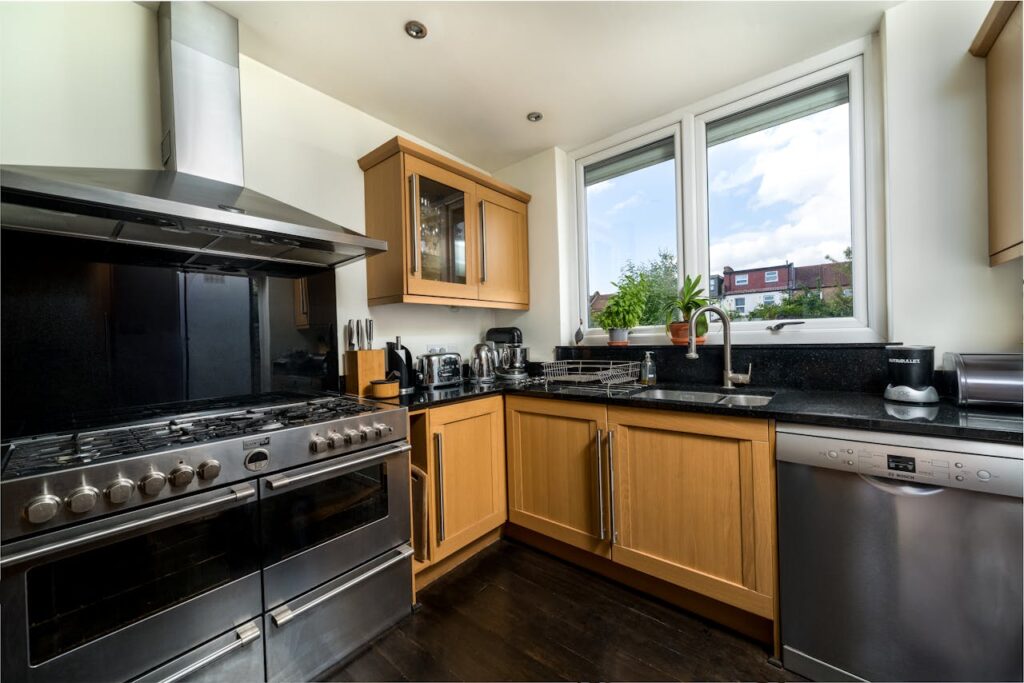
Cabinets aren’t one-size-fits-all. You need to match the cabinet sizes to your appliances. For example, your microwave might fit best inside a cabinet built just for it.
If you don’t match cabinets to appliances, you might have gaps or wasted space. A kitchen designer can help make sure cabinets and appliances work well together. This keeps your kitchen neat and your countertops clear.
- Check the exact size of your appliances before ordering cabinets.
- Make sure cabinets have enough space for appliance doors to open fully.
- Plan for built-in spaces if you want appliances like microwaves inside cabinetry.
- Coordinate with your kitchen designer to avoid gaps or awkward spaces.
Place Fridge Near Food Prep and Pantry Zones
The fridge holds your ingredients, so it makes sense to place it near where you prep food. Keeping it close to your pantry also helps you find everything easily.
When your fridge is in the right spot, you can grab items quickly without walking all around the kitchen. This saves time and makes cooking more fun during your renovation.
- Put the fridge close to where you cut, chop, and prepare food.
- Keep it near your pantry so you can easily grab ingredients.
- Avoid placing the fridge too far from the cooking area to save steps.
- Leave enough room around the fridge for the door to open wide.
Position Dishwasher Right Beside the Sink
The dishwasher works best near the sink. You rinse dishes in the sink before putting them into the dishwasher. Having them side by side means less mess and fewer spills.
This small detail helps keep your kitchen layout organized and your countertop free from clutter. It’s a simple way to make your kitchen renovation even better!
- Place the dishwasher next to the sink for easy rinsing and loading.
- Keep countertop space nearby for stacking clean or dirty dishes.
- Make sure water and power connections are close to avoid costly plumbing work.
- Check that the dishwasher door won’t block walkways when open.
Leave 15–18 Inches of Counter Space by the Oven
When you plan your kitchen layout, it’s important to have enough counter space next to your oven or cooktop. Leave about 15 to 18 inches of countertop space on at least one side of your oven. This space helps you put down hot pans safely and makes cooking easier.
If you have a kitchen island, this counter space can sometimes be part of that island. Just make sure it’s close enough to the oven to use comfortably.
- Plan at least 15 to 18 inches of countertop space beside your oven or cooktop.
- Use this space for placing hot pans or prepping food.
- If you have a kitchen island, consider using part of it for this counter space.
- Avoid putting the oven right next to the fridge or a corner.
Ensure Proper Venting for Your Range or Cooktop
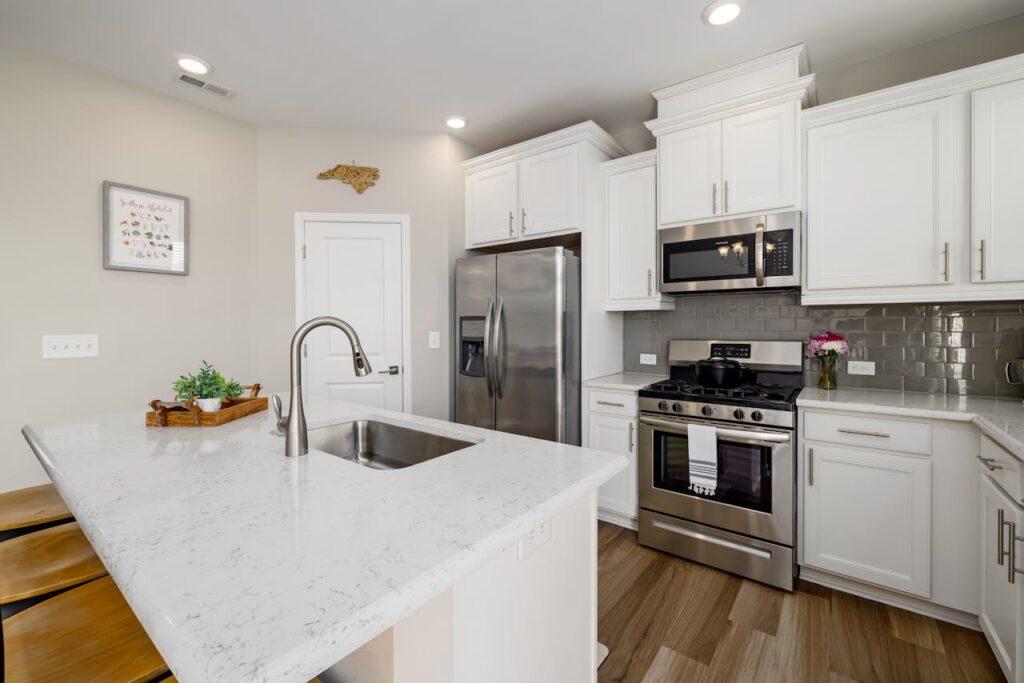
Your new appliance, especially the cooktop or range, needs good venting. This means having a range hood or vent that takes away smoke, steam, and smells from cooking.
If the vent isn’t planned right, your kitchen floor and cabinetry can get damaged by moisture or grease. A kitchen designer can help make sure the venting meets all safety rules and keeps your kitchen fresh.
- Install a vent hood that fits the size of your cooktop or range.
- Make sure vent ducts go outside to remove smoke and steam safely.
- Check local codes for proper venting requirements.
- Clean vents regularly to keep your kitchen air fresh.
Verify Power and Water Lines Meet Appliance Needs
Every kitchen appliance needs power, and some also need water. For example, your dishwasher and refrigerator with an ice maker need water lines.
Before you start your renovation, check that power outlets and water lines are in the right places for each appliance. This saves time and money later. You don’t want to move your refrigerator after the floor is finished!
- Confirm that electrical outlets match your appliance’s voltage and plug type.
- Check that water lines are positioned for dishwashers, refrigerators, and sinks.
- Talk to an electrician or plumber if you’re unsure about installation.
- Plan wiring and plumbing early to avoid delays during renovation.
Account for Door Swings and Walkways Around Units
Doors on appliances like the refrigerator, oven, and dishwasher need room to open fully. Plan your kitchen layout so doors don’t block walkways or other cabinets.
Make sure there is enough space for people to move comfortably around your kitchen. A good workflow depends on clear paths between the refrigerator, sink, and cooktop — this is called the kitchen work triangle.
- Make sure appliance doors can open fully without hitting walls or cabinets.
- Keep walkways at least 36 inches wide for easy movement.
- Avoid placing appliances where doors block paths or counters.
- Think about how many people use the kitchen at once and plan space accordingly.
Plan Storage Near Each Appliance for Efficiency
Think about where you keep items you use with each appliance. Store pots and pans near the cooktop. Keep dishes close to the dishwasher.
Good storage planning means your kitchen cabinetry fits well with your appliances. When you plan storage right, cooking and cleaning up become faster and easier.
- Store pots and pans near the cooktop or oven.
- Keep plates and glasses close to the dishwasher.
- Place food storage containers near the fridge or pantry.
- Use drawers and cabinets designed for easy access while cooking.
Include Outlets Where Countertop Appliances Go
Think about where you will use small appliances like toasters, blenders, or coffee makers. These need power outlets right on the countertop. Plan to include outlets in your backsplash or under cabinets.
If your existing kitchen doesn’t have enough outlets, adding more will make using these appliances easier and safer. No one wants to stretch cords across the countertop!
- Add outlets along the backsplash or under cabinets for small appliances.
- Space outlets so you can plug in multiple devices at once.
- Include USB ports for charging phones or tablets near prep areas.
- Use outlets with covers to keep them safe from spills.
Allow Clearance for Built-In Appliances to Vent

Built-in appliances like ovens or refrigerators need space to breathe. Make sure there is enough clearance around them so air can flow. This keeps the appliances working well and lasts longer.
Your kitchen designer can help you ensure there’s enough space for vents in your ultimate kitchen. Venting prevents overheating and keeps your appliances safe.
- Check manufacturer instructions for recommended clearance around built-ins.
- Leave gaps behind refrigerators or ovens to allow air circulation.
- Avoid sealing appliances tightly into cabinetry without vents.
- Plan vent openings or grills where needed for air flow.
Select Appliances That Fit Your Cooking Habits
Not everyone cooks the same way. Think about how you use your kitchen before choosing appliances. If you cook a lot of meals at home, a larger cooktop might be best.
If you mostly heat up food or make simple dishes, smaller appliances could work. Picking the right appliances helps your kitchen fit your lifestyle perfectly.
- Choose a cooktop size that matches how many meals you prepare.
- Pick refrigerator features based on your family size and food habits.
- Consider ovens with special settings if you bake or grill often.
- Don’t overspend on features you won’t use regularly.
Use Counter-Depth Models for Tighter Kitchens
If your kitchen is small or you want more open floor space, consider counter-depth appliances. These models are shallower than standard ones, so they don’t stick out beyond your cabinetry and countertop.
Counter-depth refrigerators, for example, blend in better with your cabinets and backsplash. This choice helps keep your kitchen looking neat and spacious.
- Counter-depth refrigerators fit flush with cabinets and don’t stick out.
- Smaller appliances free up floor space and create a cleaner look.
- These models work well in kitchens with limited floor area.
- Balance size with storage needs so you don’t lose important space.
Check Appliance Delivery Paths into Your Home
Big appliances are heavy and bulky. Before you order, check the path from your front door to your kitchen. Make sure there is enough space to carry the appliances inside without damage.
This step is important in any kitchen renovation. It can save you from a stressful delivery day and keep your new appliance safe and ready to install.
- Measure doors, hallways, and stairways to make sure appliances fit through.
- Plan where to place appliances before moving them inside.
- Protect floors and walls during delivery with mats or blankets.
- Schedule delivery times that work with your renovation timeline.
Conclusion
A kitchen remodel is a chance to make your space better for cooking and spending time with family. When you plan around your appliances, you make sure your kitchen is both beautiful and useful. Remember, the right layout and appliance choices help you save time and enjoy your kitchen more.
Take your time, measure carefully, and think about how you use your appliances now—and how you might want to use them in the future.
With good planning, your new kitchen will be a happy place for years to come.
FAQs
1. What is the 3×4 kitchen rule?
The 3×4 kitchen rule means the kitchen work triangle should total between 12 and 26 feet, with each side 3 to 4 feet apart. This creates an efficient layout between fridge, stove, and sink.
2. Is $10,000 enough for a kitchen remodel?
$10,000 can cover small kitchen remodeling projects like updating cabinets, countertops, or appliances. For a complete kitchen reno, it’s often not enough, especially if electrical or plumbing work is needed.
3. In what order should you remodel a kitchen?
Start with prep work like measuring your space, then electrical and plumbing updates. Next, install new cabinets and kitchen countertops, followed by appliances and finishes. This remodel timeline avoids costly mistakes.
4. What is the most expensive part of a kitchen remodel?
New cabinets usually cost the most in a kitchen remodel. Materials, shelves and drawers, and installation make up the biggest share of the budget.
5. How do I create a functional kitchen around appliances?
Think about the features you use most, place appliances near work areas, and leave space on either side of ovens and sinks. This creates a functional and efficient kitchen for cooking and washing dishes.
6. Should I keep my existing cabinets in a kitchen remodel?
Keeping existing cabinets can save money but may limit layout changes. If they’re in good shape, update hardware and finishes to refresh your current kitchen without a full remodel.
7. How do I plan space for appliance doors to open?
Ensure there is enough clearance for appliance doors, usually about 24 to 36 inches of walk space. Measure space to open doors fully without blocking walkways or countertops.
8. What is a landing zone in kitchen design?
A landing zone is a countertop space near the fridge or stove for placing groceries or hot pans. Including landing zones improves kitchen workflow and safety.
9. How do I choose appliances that fit my kitchen needs?
Think about how often you cook and what features matter. For example, a small kitchen might benefit from counter-depth refrigerators to save space.
10. Can a U-shaped kitchen design help with efficiency?
Yes! A U-shaped kitchen offers three connected work areas, creating an efficient layout that reduces steps and keeps work areas close together.
11. How much countertop space do I need near the oven?
Leave 15–18 inches of countertop space on one or both sides of the oven. This space helps with food prep and holding hot dishes safely.
12. Why is proper venting important for cooktops?
Proper venting removes smoke, steam, and odors. It also protects your kitchen cabinets and countertop materials from damage over time.
13. How can I plan storage near appliances?
Store frequently used items close to their appliances, like pots near the cooktop and dishes near the dishwasher. Use shelves and drawers for easy access.
14. How do I set up a temporary kitchen during remodeling?
Create a functional and efficient temporary kitchen in another part of your home with essentials like a microwave and mini fridge. This helps avoid stress while work areas are under construction.
15. What should I check before appliance delivery?
Measure delivery paths and doorways to ensure appliances fit through. Protect your floors and plan placement to avoid delays and damage during installation.

